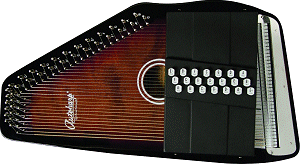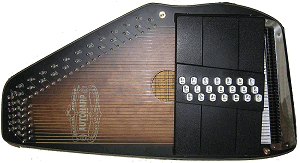Written by Paul D. Race for CreekDontRise.com(tm) Please Read: How to Help Us Boost Traditional and Acoustic Music at No Cost to You
So if we point you to something you decide to buy later, please make certain you come back through our site and click on the link directly. Thanks. |
| This Site is a Cookie-Free Zone - Except for discussion forums that you have to expressly register for, none of our pages use cookies of any kind. Some of the vendors we link to do, but that won't affect you unless you click on a link to their pages. Your continued use of this page indicates that you agree to our policy. For details, click here. |
|
Buyer's Guide for Autoharps - From Riverboat Music(tm), Autoharps are fun instruments that anyone can get a good sound out of (providing they've been tuned first). And it's possible, with practice and coaching, to get great music out of them. Furthermore, with proper care, they should last a lifetime without so much as new strings. Autoharps have had their ups and downs, including long periods of stagnation and intervals of crazy experimentation. Researching that history has led to many articles on our HarpersGuild.com page. But in the interest of practicality, I've taken the historical information out of this page, so I can focus on information you need to make a purchasing decision. That said, I have links to other articles you may find helpful near the bottom of this page. Today, there are basically two manufacturers selling off-the-shelf instruments and several custom builders who give this class of instrument the quality it deserves. Dozens of other kinds have been made in the last 135 years, but if you're looking to learn and play (not to tinker), you should consider "modern" autoharps - which is to say, the configurations that were introduced in the late 1960s and are still being produced today. "Off-the Shelf" Autoharps"Store-bought" autoharps are made in two basic flavors - 15-chord and 21-chord. They are made by two companies - Oscar Schmidt and Chromaharp (although both lines have been produced under other brand names like Samick, Airline, MEG, Sekova, etc.). Similarities include:
Differences include:
Fifteen-ChordersThe "entry-level" of both lines is currently a 15-chorder. They are fun to play and - frankly - have the same construction and number of strings as the 21-chorders from the same line.So, say, a C chord on a 15-chorder will sound about the same as a C chord on a 21-chorder from the same line. You're not sacrificing sound, just the number of chords, when you choose a 15-chorder over a 21-chorder.
Frankly, if you're a beginning player, either a Chromaharp or Oscar Schmidt autoharp 15-chorder would give you the same learning and playing experience (though most Chromaharp 15-chorders are more solid than most OS 15-chorders). No one offers a significant "upgrade" version of these 15-chorders. So if you feel the need for a better instrument, you'll probably be going to a 21-chorder or custom instrument eventually. One other point - if you're on a really tight budget, and shopping for used instruments, you'll soon discover that many more 15-chorders have been sold in the past than 21-chorders, so it's usually far easier and cheaper to get a playable used 15-chorder than a good used 21-chorder. (There is more about buying used autoharps below). 21-ChordersBoth Oscar Schmidt and Chromaharp offer 21-chord versions. Again both brands offer the same chords in the same arrangement.
Out of the box, the Chromaharp 21-chorder and the Oscar Schmidt OS21C (their entry-level 21-chorder) share essentially the same chord bar setup and similar sound. The Chromaharp 21-chorders tend to be more solid than the entry-level Oscar Schmidt OS21C. Unfortunately, Chromaharps have less manufacturer and aftermarket support than Oscar Schmidts. And, if you're ever considering reconfiguring the chord bars, as many "serious" autoharp players do, you'll learn that it's a lot easier on the Oscar Schmidt than on the Chromaharp. 15 or 21 Chords When Starting Out?If you're looking at new autoharps, you may discover that the price difference between the 15-chord autoharp you have your eyes on and its 21-chord "big brother" is only 25-30%. In that case, you might be better off saving for a few more weeks and getting the 21-chorder. (Again, if you're shopping used instruments, used 15-chorders are usually much cheaper than used 21-chorders, just because there are so many more of them.)Storage IssuesIn most situations, an autoharp will survive indefinitely if it is stored at room temperature in a situation that is neither very humid or very dry. So no attics or basements. In addition, a box, case, or gig bag that protects it from dusts and dings will reduce maintenance issues.
When you purchase your first autoharp, you may want to consider accessories to make storage and transportation safer, and to make them easier to tune and play.
| |||||||||||||||||||||||||||
| Model | ||
| Oscar Schmidt 15-chorder |  |  |
| ChromaHarp 15-chorder |  |  |
| Oscar Schmidt OS21C An electrified version is also available |  |  (This link takes you to one with a case. They also sell it without a case, but they won't let me link to it at the moment.) |
| ChromaHarp 21 |  |  |
| Oscar Schmidt OS73CE "1930s Reissue Electric" This is a reproduction designed for the movie A Mighty Wind. Non-electric and 15-chord versions are also available. |  | 
|
| Oscar Schmidt OS110 21AE "Americana" This "pro" autoharp sacrifices Ab, Cm, and Bb7 to provide E, Bm, and F#m, three chords that are important for playing many Folk, Bluegrass, and Country songs. That said, a handful of these have been produced with standard chords, so buyer beware. | 
| 
|
 Moving further upstream, I am an infrequent, but happy customer of D'Aigle Autoharps. They mostly make and sell professional instruments you'd have trouble equaling anywhere. Of course, you can order their custom harps in any chord setup you'd like. And they have a wide array of parts and accessories.
Moving further upstream, I am an infrequent, but happy customer of D'Aigle Autoharps. They mostly make and sell professional instruments you'd have trouble equaling anywhere. Of course, you can order their custom harps in any chord setup you'd like. And they have a wide array of parts and accessories.
I've bought and recommended the "Sparrow" mini-harp, a very clever adaptation of a 36-string harp, that folks with short arms can play comfortably. And it comes in under six pounds.
If you contact Pete, tell him I sent you (no, he doesn't pay me to send him customers).
I've come across several other builders whose work I respect, so if you're feeling out the "high end," feel fee to investigate, read reviews, etc.
However you chose to acquire the instrument coming into your household, we wish you the best, and we'll answer your questions if we can.
Note about Suppliers: While we try to help you get the instruments and other products you want by recommending suppliers with a good record of customer service, all transactions between you and the supplier you chose are governed by the published policies on the supplier's web site. So please print off any order confirmation screens and save copies of invoices, etc., so you can contact the appropriate supplier or invoke the product warranty should any problems occur.*
Note about Ordering Musical Instruments Online: Buy only from folks with a reasonable return policy and be sure to have any musical instrument you ordered online checked over by a professional as soon as you receive it. Every musical instrument has the potential for being damaged in shipment, even if the box looks fine when you get it. In addition, musical instruments shipped across the Pacific have a very high percentage of manufacturing defects. If you look at online reviews, a surprising percentage of the one-star reviews say something like "By the time I realized it was damaged (or had a critical manufacturing defect), the period for returns had run out, so now I'm stuck with a useless piece of . . . . " Yes, the manufacturer should have better quality control, and the store should pack things better. But in the end, you are responsible for making certain that an instrument or product will serve your needs while you still have time to return it.
Note about Availability and Pricing: Although I try to keep an eye on things and to recommend products that are reasonably available, the musical instrument market does fluctuate, and any product on this page may change price or become unavailable without prior notice. If you "click through" to see details on a product, and nothing happens at all, or you are routed to a supplier's home page, please let me know and I will remove the product from the online listing until I can find a replacement or another supplier.
*Here's an irony: every year, I receive about a dozen complaints from folks who have never been to my sites before, angry that a deal between that person and a vendor or manufacturer I recommend went south (in their opinion). They "googled" the product, saw my recommendation or review, then e-mailed me to tell me they were going to sue me or report me to the Better Business Bureau for personally ripping them off by recommending a product they had bought from someone else. Ninety-nine times out of a hundred, the problem is really because the customer didn't read the whole ad, or ordered the wrong thing, or threw away his paperwork and doesn't know where he bought it from, etc. I'm always polite, and sometimes I can even help them get things straightened out with the vendor, but it's not, technically, my problem.
Click here to return to the text.

| Visit related pages and affiliated sites: | ||||||
| - Music - | ||||||

|
 |
 |

|

|

|
|

|

|

|

|

|

|
|
| - Trains and Hobbies - | ||||||
 |

|

|  |
 |

|
|
| - Christmas Memories and Collectibles - | ||||||
 |

|
 |

|
 |

|
|
| - Family Activities and Crafts - | ||||||
 |

|

|

|

|

|
|